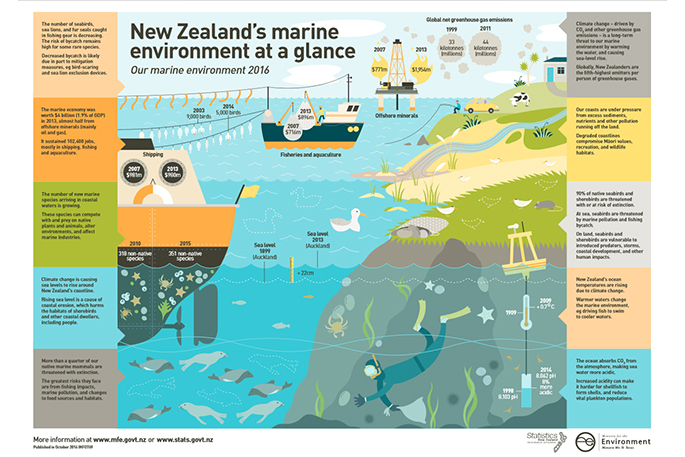Many of New Zealand's native marine birds and mammals are being threatened with extinction, and our coasts are the most degraded of all marine areas due to sediment and nutrients washed off the land, introduced marine pests, and seabed trawling and dredging.
New Zealand's oceans, coasts, and marine wildlife are also under growing pressure, and global greenhouse gas emissions are causing ocean acidification and warming – changes predicted to continue for generations is a third item of major concern.
These harrowing findings are contained in the ‘Our marine environment 2016' report – the first national report of its kind – which has been jointly released by the Ministry for the Environment and Statistics New Zealand today.
'We're a maritime nation. Having healthy and resilient oceans is important for all New Zealanders and for our economy. Today's marine environment report shows that our marine environment is facing a number of serious challenges,” says Government Statistician Liz MacPherson.
Secretary for the Environment Vicky Robertson says our oceans are facing multiple and cumulative pressures that have been building over generations. They are pressures from both land and sea-based human activities.
The report shows that one of the biggest challenges for our oceans comes from global greenhouse gas emissions, says Vicky.
'Our waters have become more acidic from absorbing excess CO2. This affects the creatures that live there. Among other things, ocean acidification makes it more difficult for shellfish, like paua and mussels, to form shells.
'Climate change is also warming the ocean and causing sea-level rises, which impact not only on fish but also other wildlife and our own coastal communities.”
Some marine wildlife and coastal habitats are in a fragile state.
'Ninety per cent of our native seabirds and shorebirds are threatened with or at risk of extinction,” says Vicky. 'More than a quarter of our native marine mammals are threatened with extinction. Fishing bycatch, introduced predators, and habitat change are among a raft of reasons for the poor state of much marine wildlife.”
 New Zealand's marine environment at a glance. Click on the infographic above to view a larger version. Image: MRF/SNZ
New Zealand's marine environment at a glance. Click on the infographic above to view a larger version. Image: MRF/SNZ
Where challenges have been identified and issues addressed they are seeing results. For example, changes in fishing practices in recent years have eased some pressures on the marine environment.
'The number of seabirds caught by commercial fishing bycatch almost halved from around 9000 in 2003 to 5000 in 2013. The improvements are likely to be helped by mitigation measures, such as bird-scaring and sea lion exclusion devices,” says Vicky.
'By shining a light on the issues through this report we are able to focus on the most pressing and urgent areas to address. It also gives us a better understanding of the size of the challenges ahead. We now have to come together to focus on what each of us can do to protect its future.”
National data on many marine issues are limited, but the report also draws on scientific literature and expert opinion, says Vicky.
'Another theme that came through in producing this report is how much we don't know about our marine environment. The environmental reporting programme is working to improve our data over time. However, New Zealanders need to consider the costs of delaying action in the absence of perfect information.”
The report is the first since the Environmental Reporting Act was enacted in June 2016. The next report – about fresh water – will be out in April 2017.
Statistics NZ's companion report, ‘New Zealand's marine economy: 2007–13' which was also released today, shows the marine economy contributed 1.9 per cent, or $4 billion, to the NZ gross domestic product (GDP) in 2013, about the same as the 2 per cent contribution in 2007.
Offshore minerals mainly oil and gas were the largest contributor to the marine economy, at $2 billion in 2013. Shipping contributed $980 million and fisheries and aquaculture contributed $896 million.
The marine economy provided 102,400 jobs, mostly in shipping, fishing and aquaculture.
To read the ‘Our marine environment 2016' report in full visit the Ministry for the Environment website.

A container and debris washed up on the coastline just south of Mount Maunganui following the Rena Disaster in 2011. File Photo.



0 comments
Leave a Comment
You must be logged in to make a comment.